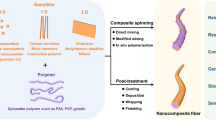Abstract
Polymeric materials have wide applications; therefore, it is necessary to develop a dynamic constitutive model to investigate their strain rate-dependent mechanical behavior. In this study, mechanical behavior of neat epoxy and carbon nanofiber (CNF)/epoxy nanocomposites were studied experimentally and analytically. For this purpose, the Johnson–Cook material model has been modified to develop a generalized strain rate-dependent constitutive model to simulate the tensile and shear mechanical behaviors of the neat epoxy at a wide range of applied loading rates. The present model includes three main components: the first component expresses the elastic behavior of polymers using an empirical equation. The second component models the nonlinear behavior of polymers using the modified Johnson–Cook model. Finally, the third component predicts the ultimate strength of polymers under dynamic loading conditions using another empirical equation. Furthermore, by combining the generalized strain rate-dependent constitutive model and the modified Halpin–Tsai micromechanical model, a dynamic constitutive-micromechanical model is presented to predict the strain rate-dependent mechanical behavior of CNF/epoxy nanocomposites. To evaluate the present model, predicted results for the pure epoxy and CNF/epoxy nanocomposites were compared with conducted and available experimental data. It is shown that the present model predicts the strain rate-dependent mechanical behavior of polymeric materials with a good accuracy.










Similar content being viewed by others
References
Gilat A, Goldberg RK, Roberts GD (2007) Strain rate sensitivity of epoxy resin in tensile and shear loading. J Aerosp Eng 20:75–89
Johnson GR, Cook WH (1983) A constitutive model and data for metals subjected to large strains, high strain rates and high temperatures. In: Proc 7th Int Symp Ballistic 21:541–547
Zerilli FJ, Armstrong RW (1987) Dislocation-mechanics-based constitutive relations for material dynamics calculations. J Appl Phys 61:1816–1825
Meyer HW (2006) A modified Zerilli–Armstrong constitutive model describing the strength and localizing behavior of Ti–6A1–4V. Army Research Laboratory, ARL-CR-0578
Lin YC, Chen XM (2010) A combined Johnson–Cook and Zerilli–Armstrong model for hot compressed typical high-strength alloy steel. Comp Mater Sci 49:628–633
Holmquist TJ, Johnson GR (1991) Determination of constants and comparison of results for various constitutive models. J phys IV France 1:C3-853–C3-860
Huh H, Kang WJ (2002) Crash-worthiness assessment of thin-walled structures with the high-strength steel sheet. Int J Vehicle Des 30:1–21
Lin YC, Chen XM, Liu G (2010) A modified Johnson–Cook model for tensile behaviors of typical high-strength alloy steel. Mater Sci Eng A 527:6980–6986
Zhang H, Wen W, Cui H (2009) Behaviors of IC10 alloy over a wide range of strain rates and temperatures: experiments and modeling. Mater Sci Eng A 504:99–103
Arruda EM, Boyce MC, Jayachandran R (1995) Effects of strain rate, temperature and thermomechanical coupling on the finite strain deformation of glassy polymers. Mech Mater 19:193–212
Tervoort TA, Smit RJM, Brekelmans WAM, Govaert LE (1998) A constitutive equation for the elasto-viscoplastic deformation of glassy polymers. Mech Time Depend Mat 1:269–291
Plaseied A, Fatemi A (2008) Deformation response and constitutive modeling of vinyl ester polymer including strain rate and temperature effects. J Mater Sci 43:1191–1199
Goldberg RK, Roberts GD, Gilat A (2005) Implementation of an associative flow rule including hydrostatic stress effects into the high strain rate deformation analysis of polymer matrix composites. J Aerosp Eng 18:18–27
Goldberg RK, Stouffer DC (2002) Strain rate dependent analysis of a polymer matrix composite utilizing a micromechanics approach. J Compos Mater 36:773–793
Bodner SR, Partom Y (1975) Constitutive equations for elastic-viscoplastic strain-hardening materials. J Appl Mech 42:385–389
Zheng X (2006) Nonlinear strain rate dependent composite model for explicit finite element analysis. PhD thesis, University of Akron
Duan Y, Saigal A, Greif R (2001) A uniform phenomenological constitutive model for glassy and semicrystalline polymers. Polym Eng Sci 41:1322–1328
Weon JI (2009) Mechanical and thermal behavior of polyamide-6/clay nanocomposite using continuum-based micromechanical modeling. Macromol Res 17:797–806
Ingram J, Zhou Y, Jeelani S, Lacy T, Horstemeyer MF (2008) Effect of strain rate on tensile behavior of polypropylene and carbon nanofiber filled polypropylene. Mater Sci Eng A 489:99–106
Shokrieh M, Mosalmani R, Omidi M (2014) Strain rate dependent micromechanical modeling of reinforced polymers with carbon nanotubes. J Compos Mater 48:3381–3393
Shokrieh MM, Shamaei Kashani A, Mosalmani R (2015) A dynamic-micromechanical constitutive model to predict the strain rate dependent shear behavior of neat and reinforced polymers with carbon nanofibers. Modares Mech Eng 15:13–21
Chitsazzadeh M, Shahverdi H, Shokrieh M (2011) Fabrication of multi-walled carbon nanotube/vinyl ester nanocomposites: dispersion and stabilization. J Defect Diffus Forum 312–315:460–465
Shokrieh M, Mosalmani R, Shamaei AR (2015) A combined micromechanical–numerical model to simulate shear behavior of carbon nanofiber/epoxy nanocomposites. Mater Des 67:531–537
Al-Saleh MH, Sundararaj U (2011) Review of the mechanical properties of carbon nanofiber/polymer composites. Compos Part A Appl Sci Manuf 42:2126–2142
Colloca M, Gupta N, Porfiri M (2013) Tensile properties of carbon nanofiber reinforced multiscale syntactic foams. Compos Part B Eng 44:584–591
Panov V (2006) Modelling of behaviour of metals at high strain rates. PhD thesis, Cranfield University
Halpin Affdl JC, Kardos JL (1976) The Halpin–Tsai equations: a review. Polym Eng Sci 16:344–352
Sun LH, Ounaies Z, Gao XL, Whalen CA, Yang ZG (2011) Preparation, characterization, and modeling of carbon nanofiber/epoxy nanocomposites. J Nanomater 2011:1–8
Author information
Authors and Affiliations
Corresponding author
Rights and permissions
About this article
Cite this article
Shokrieh, M.M., Kashani, A.R.S. & Mosalmani, R. A dynamic constitutive-micromechanical model to predict the strain rate-dependent mechanical behavior of carbon nanofiber/epoxy nanocomposites. Iran Polym J 25, 487–501 (2016). https://doi.org/10.1007/s13726-016-0441-9
Received:
Accepted:
Published:
Issue Date:
DOI: https://doi.org/10.1007/s13726-016-0441-9




